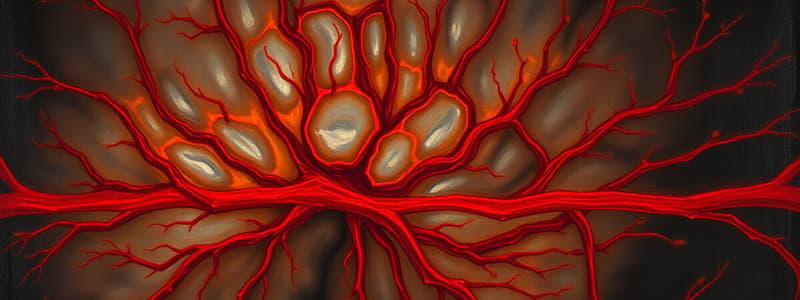Podcast
Questions and Answers
What is a characteristic function of precapillary sphincters in true capillaries?
What is a characteristic function of precapillary sphincters in true capillaries?
- They facilitate the exchange of gases and nutrients.
- They maintain the structural integrity of the capillary.
- They contract or relax to regulate blood entry. (correct)
- They operate independently of metarterioles.
How does blood flow through capillaries when precapillary sphincters are closed?
How does blood flow through capillaries when precapillary sphincters are closed?
- Blood flow is halted completely in the capillary network.
- Blood flows continuously into the capillaries.
- Blood is diverted back to the arteries.
- Blood flows directly from metarterioles to post capillary venules. (correct)
What role do tight junctions play in capillaries?
What role do tight junctions play in capillaries?
- They support the rhythmic contraction of muscle fibers.
- They regulate the permeability of the capillary walls. (correct)
- They prevent the formation of basal lamina.
- They promote nutrient absorption from surrounding tissues.
What structural feature is often observed in the nuclei of capillary cells?
What structural feature is often observed in the nuclei of capillary cells?
What distinguishes the structural variation in capillaries across different organs?
What distinguishes the structural variation in capillaries across different organs?
What is the primary function of capillaries in the circulatory system?
What is the primary function of capillaries in the circulatory system?
Which type of capillary has pores that allow for increased permeability?
Which type of capillary has pores that allow for increased permeability?
What is the average diameter of capillaries, which allows blood cells to transit one at a time?
What is the average diameter of capillaries, which allows blood cells to transit one at a time?
What role do pericytes play in the structure of capillaries?
What role do pericytes play in the structure of capillaries?
In which situation is blood flow to capillary beds maximally efficient?
In which situation is blood flow to capillary beds maximally efficient?
How is blood oxygenation characterized as it moves through the capillaries?
How is blood oxygenation characterized as it moves through the capillaries?
What is not a characteristic of continuous capillaries?
What is not a characteristic of continuous capillaries?
What is a common clinical condition associated with capillary dysfunction?
What is a common clinical condition associated with capillary dysfunction?
Which characteristic is specific to fenestrated capillaries when compared to other types of capillaries?
Which characteristic is specific to fenestrated capillaries when compared to other types of capillaries?
What role do pericytes play in the maintenance of the blood-brain barrier?
What role do pericytes play in the maintenance of the blood-brain barrier?
What is a consequence of the larger diameter of fenestrated capillaries?
What is a consequence of the larger diameter of fenestrated capillaries?
What physiological change occurs in pericytes following tissue injury?
What physiological change occurs in pericytes following tissue injury?
Which of the following organs does NOT typically contain fenestrated capillaries?
Which of the following organs does NOT typically contain fenestrated capillaries?
In diabetic microangiopathy, what is the primary effect on capillaries?
In diabetic microangiopathy, what is the primary effect on capillaries?
How do fenestrated capillaries differ structurally from continuous capillaries?
How do fenestrated capillaries differ structurally from continuous capillaries?
What is a key function of capillaries in relation to pericytes?
What is a key function of capillaries in relation to pericytes?
What role do pericytes play in relation to fenestrated capillaries?
What role do pericytes play in relation to fenestrated capillaries?
Which of the following features allows fenestrated capillaries to be more permeable than continuous capillaries?
Which of the following features allows fenestrated capillaries to be more permeable than continuous capillaries?
How do pericytes respond to vasoactive agents like histamine?
How do pericytes respond to vasoactive agents like histamine?
What type of vascular structure is often found along continuous capillaries and postcapillary venules?
What type of vascular structure is often found along continuous capillaries and postcapillary venules?
Which cell type is included in the pericyte population and is vital for tissue regeneration?
Which cell type is included in the pericyte population and is vital for tissue regeneration?
Fenestrated capillaries are primarily known for which of the following functions?
Fenestrated capillaries are primarily known for which of the following functions?
What is a major consequence of hyperglycemia on capillary function?
What is a major consequence of hyperglycemia on capillary function?
What structure is primarily disrupted in diabetic microangiopathy?
What structure is primarily disrupted in diabetic microangiopathy?
What is the primary function of pericytes in relation to capillaries?
What is the primary function of pericytes in relation to capillaries?
What structural characteristic allows for greater exchange across endothelial layers?
What structural characteristic allows for greater exchange across endothelial layers?
Which component do pericytes secrete that supports their function?
Which component do pericytes secrete that supports their function?
What is a distinguishing feature of progressively larger collecting venules?
What is a distinguishing feature of progressively larger collecting venules?
Which proteins are primarily found in the cytoskeletal network of pericytes?
Which proteins are primarily found in the cytoskeletal network of pericytes?
How do pericytes interact with endothelial cells?
How do pericytes interact with endothelial cells?
What effect do pericytes have on the blood flow of red blood cells?
What effect do pericytes have on the blood flow of red blood cells?
Which statement accurately describes the relationship between pericytes and basal lamina?
Which statement accurately describes the relationship between pericytes and basal lamina?
Flashcards are hidden until you start studying
Study Notes
Capillaries Overview
- Capillaries are the smallest blood vessels, with an average diameter of 4 to 10 μm and a wall thickness of only 0.25 μm.
- They facilitate nutrient, waste, O2, and CO2 exchange through their endothelial structure.
- Blood enters capillary beds in a pulsatile manner due to the contraction of precapillary sphincters.
Types of Capillaries
-
Continuous Capillaries:
- Composed of a single layer of endothelial cells forming a tube.
- Characterized by tight junctions and few gaps, allowing selective permeability.
-
Fenestrated Capillaries:
- Contain pores (fenestrations) around 80 nm in diameter, enhancing exchange capabilities.
- Found in organs like the liver, spleen, some endocrine glands, and bone marrow.
- Possess a discontinuous basal lamina and larger diameters (30-40 μm), which slow blood flow.
-
Discontinuous Capillaries:
- Have large openings with a discontinuous endothelial layer, permitting maximal substance interchange.
Pericytes
- Mesenchymal cells located alongside continuous capillaries and postcapillary venules.
- Involved in maintaining the endothelial blood-brain barrier within the CNS.
- Regulate blood flow by contracting or dilating capillaries, with a significant role in tissue regeneration after injuries.
Venules
- Formed from the convergence of postcapillary venules into larger collecting venules.
- As they increase in size, they develop tunica media with smooth muscle layers, termed muscular venules.
- Facilitate the collection of blood from capillaries and act as sites for material exchange and white blood cell migration into tissues.
Clinical Application
- Diabetic Microangiopathy:
- A consequence of hyperglycemia in diabetes leading to diffuse thickening of capillary basal laminae.
- Impairs metabolic exchange, notably affecting the kidneys, retina, skeletal muscle, and skin.
Studying That Suits You
Use AI to generate personalized quizzes and flashcards to suit your learning preferences.




